Steady-State Response Analysis of the Incompressible Nonlocal Saturated Poroelastic Beam under a Vertical Harmonic Load
Abstract
Based on the nonlocal theory and the theory of saturated porous media, the mathematical and physical model and governing equations of the steady-state response of the incompressible nonlocal saturated poroelastic beam under vertical harmonic loading are established with assumption of the movement of the liquid-phase fluid only in the axial direction of the beam and considering the nonlocal effects such as particle size, pore size, and pore dynamic stress. The dynamic response of a saturated poroelastic cantilever beam with permeability at both ends under a vertical harmonic concentrated force at the free end is studied. In the frequency domain, the analytical expressions of deflection amplification factor and equivalent couple amplification factor of liquid fluid pressure are given. The effects of nonlocal coefficient τ, mechanical parameter α, and geometric parameter β on the deflection amplification factor and equivalent couple amplification factor at the midpoint of the nonlocal saturated poroelastic cantilever beam are studied. The results show that the steady-state vibration of the incompressible nonlocal saturated poroelastic cantilever beam has resonance. When the nonlocal effect is considered, the deflection amplification factor and the equivalent couple amplification factor are larger, so the influence of the nonlocal effect on the steady-state response of the beam should not be ignored. The geometric parameter β has significant effect on the peak positions of the curves of the deflection amplification factor and the equivalent couple amplification factor varying with frequency.
1. Introduction
Saturated porous structures are widely used in civil engineering, aviation, transportation, and other engineering fields because of their good sound absorption and energy consumption. The research on the mechanical behavior of saturated porous structures has significant engineering application value and academic value. Therefore, since Biot put forward the theory of saturated porous media [1, 2], the research on vibration and wave propagation in saturated porous media has attracted the attention of many scholars [3–9]. Since Biot theory assumes that the wave length of saturated porous media is larger than the pore size, the influence of pore size effect on wave propagation is not considered and the influence of pore size is very significant at high frequency [10]. As a method of engineering description, Biot theory has some defects in the model [11] and it is difficult to determine the elastic constant and inertial coupling coefficient in the Biot dynamic equation. The porous media theory based on the mixture axiom and the concept of volume fraction is more rigorous and reasonable. The concept of volume fraction in porous media theory can avoid the incompatibility of the model and can also consider the effects of dynamic, material, and geometric nonlinearity. Aiming at the static and dynamic problems of saturated porous structures, Busse et al. [12] established the dynamic mathematical model of the saturated poroelastic Mindlin plate based on Biot theory and gave the virtual work principle with rotation angle, deflection, and pore stress as basic unknowns. Iesan and Nappa [13] studied the thermal stress of poroelastic cylinders and circular tubes. Li et al. [14] studied the transverse vibration of fluid saturated poroelastic beams and obtained the solutions of free vibration and forced vibration. Cederbaum et al. [15] studied the mechanical behavior of saturated poroelastic beams and rods and pointed out that Mandel–Cryer phenomenon also exists in the deformation response of poroelastic beams and rods. Xiao and Chen [16] established the nonlinear governing equation of large deflection of the incompressible saturated poroelastic beam under the constraint that the pore fluid only diffuses along the axial direction of the beam and studied the nonlinear bending problem of the saturated poroelastic cantilever beam with fixed impermeability at one end and free permeability at another end under a sudden constant transverse concentrated load at the free end. However, in the analysis of mechanical behavior of saturated porous structures, the scale effects such as solid skeleton particle size, pore size, and pore stress are not considered. As the engineering structure is developing towards miniaturization and intelligence, it is more and more important to consider the influence of structural scale effect on mechanical properties. The nonlocal theory in [17, 18] believes that the stress at a point in the continuum is related not only to the strain at that point but also to the strain and deformation history of all points in the area near the point. The nonlocal theory considering the scale effect is mainly used to study the mechanical problems of nanostructures. In recent years, scholars began to combine the nonlocal theory with the Biot saturated soil theory [19, 20] and apply it to the field of geotechnical engineering. In this paper, the dynamic control equation of the incompressible nonlocal saturated poroelastic beam under a vertical simple harmonic load is established by combining the porous medium theory and nonlocal theory and the steady-state response of the saturated poroelastic cantilever beam with permeable ends under simple harmonic concentrated force at the free end is studied.
2. Mathematical Model and Basic Equation
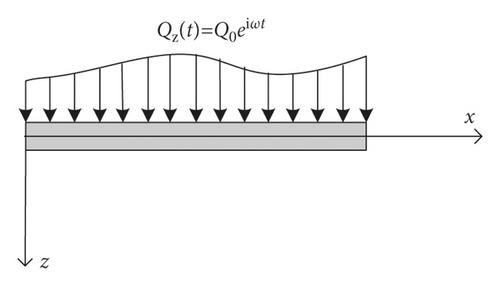
3. Dynamic Control Equation of the Incompressible Nonlocal Saturated Poroelastic Beam
Equations (25) and (26) are the vertical dynamic control equations of the incompressible nonlocal saturated poroelastic beams.
4. Steady-State Response of the Incompressible Nonlocal Saturated Poroelastic Cantilever Beam under a Vertical Simple Harmonic Load
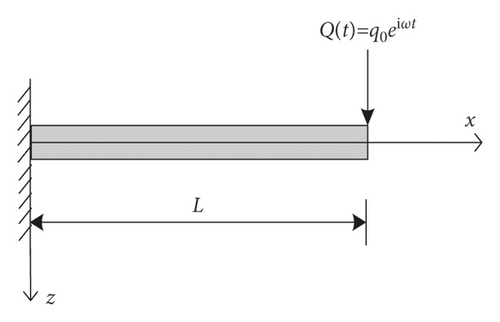
Under the action of the simple harmonic load, the incompressible nonlocal saturated poroelastic cantilever beam vibrates in a steady state. Considering the harmony of the problem, the parameters meet , , and , where , , and are the amplitudes of wS, Mp, and , respectively. The following equations can be obtained by substituting wS, Mp, and into vertical dynamic control equations (25) and (26) of the incompressible nonlocal saturated poroelastic beam:
5. Numerical Examples
Based on the obtained deflection amplification factor w and equivalent couple amplification factor g of the incompressible nonlocal saturated poroelastic cantilever beam under vertical simple harmonic concentrated force, the steady-state dynamic response characteristics of the incompressible nonlocal saturated poroelastic cantilever beam are analyzed through numerical examples. If there is no special description, the dimensionless quantities are τ = 0.05, α = 20, and β = 10. Figures 3–8 show the curves of mid-span deflection amplification factor w and equivalent couple amplification factor g of the incompressible nonlocal saturated poroelastic cantilever beam varying with dimensionless frequency ωL/ v for different values of nonlocal coefficient τ, mechanical parameter α, and geometric parameter β. Evidently, there are obvious peaks and troughs in the curves, which shows that there is resonance in the vertical vibration of the incompressible nonlocal saturated poroelastic cantilever beam under a simple harmonic load. When the frequency is large, because the structure has no time to reflect, the deflection amplification factor of the cantilever beam gradually approaches zero, while the equivalent couple amplification factor tends to a stable value. Figures 9–14 show the variation curves of the deflection amplification factor and equivalent couple amplification factor at different positions of the beam varying with x/L when the dimensionless frequency ωL/v = 1.0 for different values of nonlocal coefficient τ, mechanical parameter α, and geometric parameter β. Since the external concentrated force acts at x/L = 1, the deflection amplification factor increases gradually with the increase in x/L and the equivalent couple amplification factor in the middle of the span is the largest, which has a certain relationship with its boundary conditions.

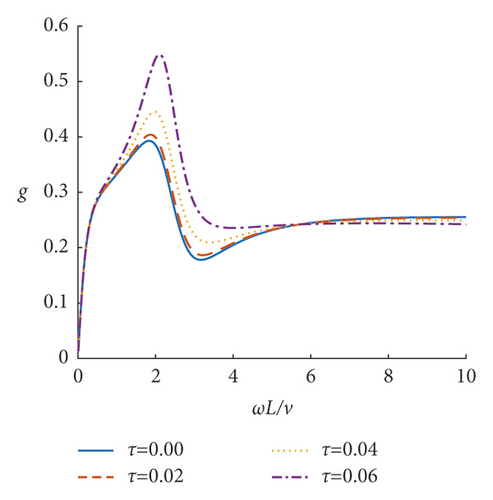
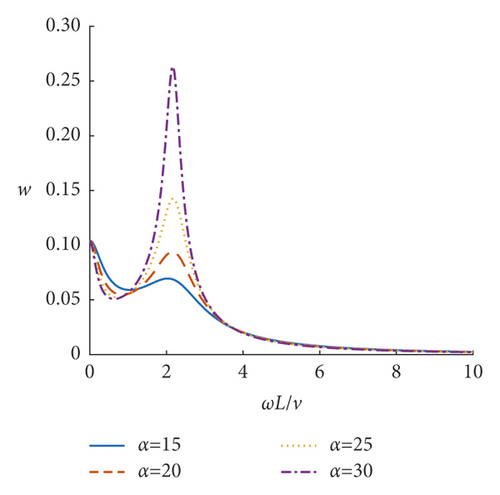
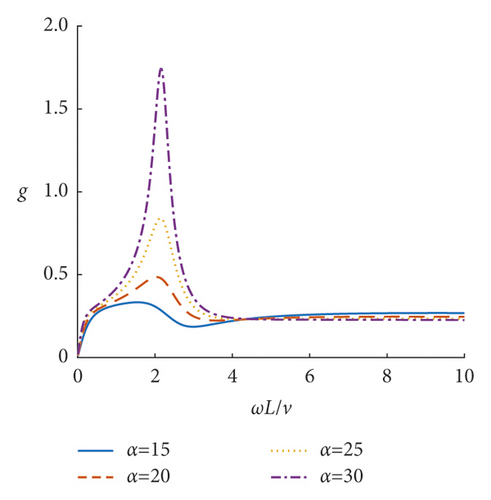
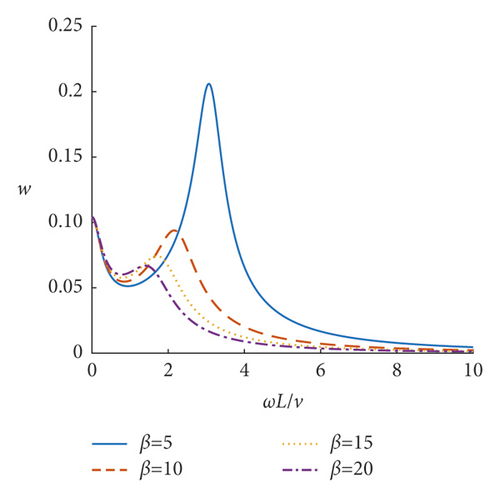
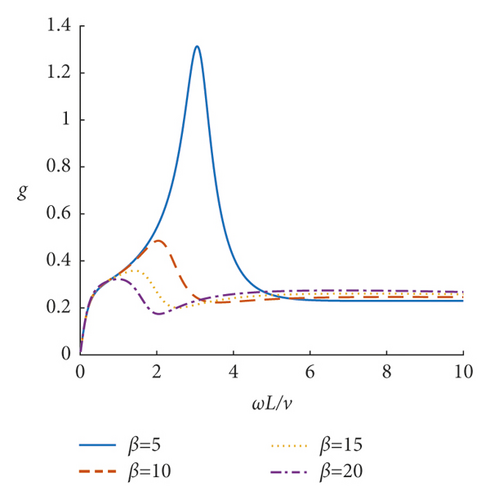
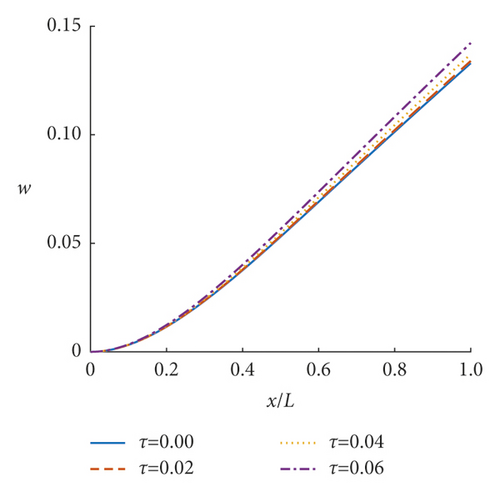

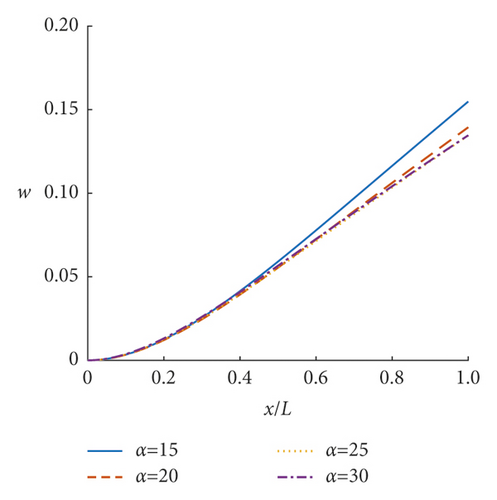
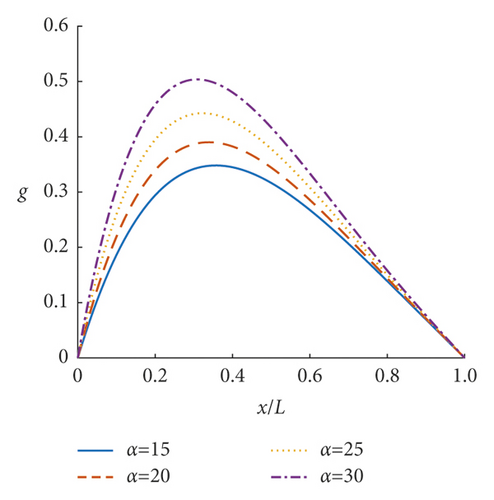
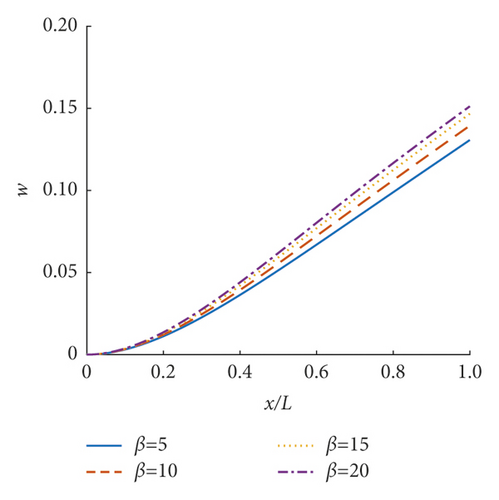
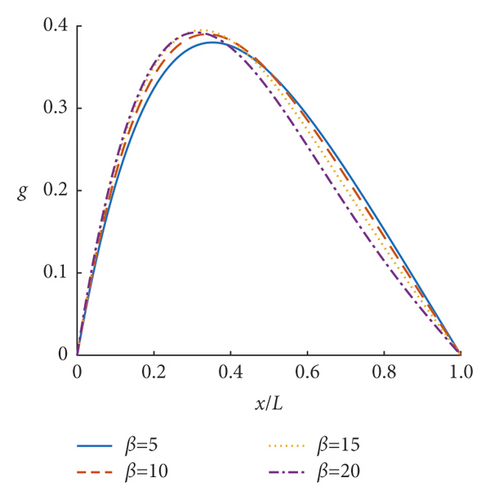
The influence of nonlocal coefficient τ on the deflection amplification factor and equivalent couple amplification factor is shown in Figures 3, 4, 9, and 10; τ = 0 is the result of ignoring the influence of nonlocal effects such as solid particle size and pore size. The deflection amplification factor and equivalent couple amplification factor are larger when nonlocal effects are considered than when they are not considered. Therefore, the influence of nonlocal effects on the steady-state response of the beam should not be ignored, and the deflection amplification factor and equivalent couple amplification factor increase with the increase of nonlocal factors. In addition, when τ is small, because the left end of the beam is a fixed end, the influence of the nonlocal coefficient τ on the deflection amplification factor and the equivalent couple amplification factor is relatively small.
The influence of the mechanical parameter α on the deflection amplification factor and equivalent couple amplification factor is shown in Figures 5, 6, 11, and 12. When the dimensionless frequency is small (ωL/v < 1.0), the larger the parameter α is, the smaller the deflection amplification factor and the larger the valley value will be. When the dimensionless frequency is large (ωL/v < 1.0), the larger the parameter α is, the larger the deflection amplification factor and the greater the peak value will be. The equivalent couple amplification factor increases with the increase in parameter α. But parameter α has little effect on the peak position of the curve of the deflection amplification factor and equivalent couple amplification factor varying with frequency.
The influence of the geometric parameter β on the deflection amplification factor and equivalent couple amplification factor is shown in Figures 7, 8, 13 and 14. The larger the parameter β is, the larger the deflection amplification factor and the smaller the valley value will be, when the dimensionless frequency is small. The larger the parameter β is, the smaller the deflection amplification factor and the smaller the peak value will be, when the dimensionless frequency is large. When the dimensionless frequency is small, the equivalent couple amplification factor increases with the parameter β; when the frequency is large, it shows the opposite, but the difference is relatively small. Different from the parameter α, the parameter β has a significant influence on the peak position of the curve of the deflection amplification factor and equivalent couple amplification factor varying with frequency. With the increase in the parameter β, the frequency corresponding to the peak value of the curve of the deflection amplification factor and equivalent couple amplification factor will increase.
6. Conclusions
Combining the nonlocal elastic theory with the porous medium theory and considering the nonlocal effects such as solid skeleton particle size, pore size, and pore dynamic stress, the dynamic control equation of the incompressible nonlocal saturated poroelastic cantilever beam is established. Taking the saturated porous cantilever beam as an example, the response of the beam under the vertical harmonic concentrated force at the free end is studied. The main conclusions are as follows: (1) there is resonance in the vertical vibration of the incompressible nonlocal saturated poroelastic cantilever beam under a simple harmonic load; (2) the deflection amplification factor and equivalent couple amplification factor with nonlocal effect are larger than those without nonlocal effect, so the influence of the nonlocal effect on the steady-state response of the beam should not be ignored; (3) the mechanical parameter α and geometric parameter β have a significant influence on the deflection amplification factor and the equivalent couple amplification factor, and the influence law has a certain relationship with the frequency; (4) the parameter β has a significant influence on the peak position of the curve of the deflection amplification factor and equivalent couple amplification factor varying with frequency, and α has little effect on the peak position.
Conflicts of Interest
The author declares no conflicts of interest.
Acknowledgments
This work was supported by the National Natural Science Foundation of China (No. U1504505).
Open Research
Data Availability
The data used to support the findings of this study are included within the article.




